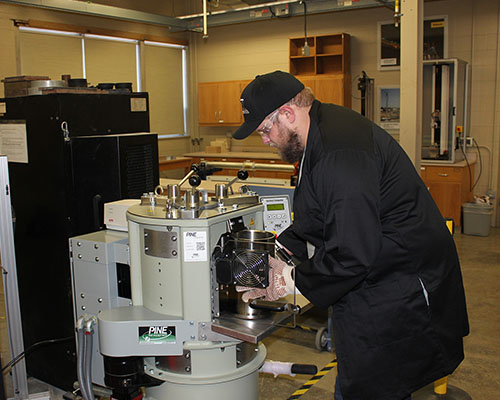Project Details
Abstract
 To achieve an adequate field density in hot mix asphalt (HMA) construction, depending on the asphalt binder type, asphalt mixes are laid down while the mix temperature exceeds 120°C. In the cold regions, the foregoing mix temperature requirements limit the seasonal construction window, negatively affecting the pavement construction and preservation operations. Incorporating warm mix asphalt (WMA) additives in the asphalt mixes provides the workability necessary for the compaction of the mixes at temperatures lower than those required for the HMA while achieving the desired field density. At low ambient temperatures, WMA additives are used as a compaction aid to continue paving operations and still achieve acceptable compaction for HMA. In this process, different types of WMA additives with different amounts are used depending on the project location, product availability, and the experience of the agencies or contractors. However, the effectiveness of the WMA additives in improving the compaction practices based on the local aggregates, asphalt binders, and temperature ranges occurring in the Upper Midwest is unclear. More specifically, laboratory or field data based on which the allowable minimum ambient construction temperature for each type of WMA additive can be determined is missing. Through a laboratory study, this project will evaluate the compaction efficacy of different WMA additives when used as a compaction aid or temperature reduction agent in producing the HMA and WMA mixes using advanced wireless compaction monitoring sensors. The collected data will be applied to determine the minimum allowable mix temperature for compaction in the cold regions based on the type of mix and additive used. In addition, the minimum allowable ambient temperatures for compaction will be determined based on the available methods of estimating the effect of solar energy, wind, and mat thickness on the cooling rate of the pavement using available thermal diffusivity and conductivity models. Furthermore, the impact of WMA additives on the resistance of the mixes to rutting, stripping, and cracking at intermediate and low temperatures will be determined in this study. The findings of this study are expected to facilitate the data-driven selection of the WMA additives and minimum allowable compaction temperatures in cold regions to maximize the performance, economic, and environmental benefits of the WMA technology and extend the lifespan of the pavements.
To achieve an adequate field density in hot mix asphalt (HMA) construction, depending on the asphalt binder type, asphalt mixes are laid down while the mix temperature exceeds 120°C. In the cold regions, the foregoing mix temperature requirements limit the seasonal construction window, negatively affecting the pavement construction and preservation operations. Incorporating warm mix asphalt (WMA) additives in the asphalt mixes provides the workability necessary for the compaction of the mixes at temperatures lower than those required for the HMA while achieving the desired field density. At low ambient temperatures, WMA additives are used as a compaction aid to continue paving operations and still achieve acceptable compaction for HMA. In this process, different types of WMA additives with different amounts are used depending on the project location, product availability, and the experience of the agencies or contractors. However, the effectiveness of the WMA additives in improving the compaction practices based on the local aggregates, asphalt binders, and temperature ranges occurring in the Upper Midwest is unclear. More specifically, laboratory or field data based on which the allowable minimum ambient construction temperature for each type of WMA additive can be determined is missing. Through a laboratory study, this project will evaluate the compaction efficacy of different WMA additives when used as a compaction aid or temperature reduction agent in producing the HMA and WMA mixes using advanced wireless compaction monitoring sensors. The collected data will be applied to determine the minimum allowable mix temperature for compaction in the cold regions based on the type of mix and additive used. In addition, the minimum allowable ambient temperatures for compaction will be determined based on the available methods of estimating the effect of solar energy, wind, and mat thickness on the cooling rate of the pavement using available thermal diffusivity and conductivity models. Furthermore, the impact of WMA additives on the resistance of the mixes to rutting, stripping, and cracking at intermediate and low temperatures will be determined in this study. The findings of this study are expected to facilitate the data-driven selection of the WMA additives and minimum allowable compaction temperatures in cold regions to maximize the performance, economic, and environmental benefits of the WMA technology and extend the lifespan of the pavements.
Project Word Files
project files
- UTC Project Information (Word, 88K)
Note to project PIs: The UTC document is limited to two pages. Also, it would be helpful if the Track Changes feature is used when editing either document above. Updated documents should be emailed to ndsu.ugpti@ndsu.edu.